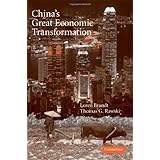
Average Reviews:

(More customer reviews)Are you looking to buy China's Great Economic Transformation? Here is the right place to find the great deals. we can offer discounts of up to 90% on China's Great Economic Transformation. Check out the link below:
>> Click Here to See Compare Prices and Get the Best Offers
China's Great Economic Transformation ReviewThe authors begin by summarizing China's economic environment prior to the reforms begun by Deng Xiaoping in 1979. Product and process innovations were pushed aside in favor of simply "fulfilling the plan," unless innovation was specifically ordered. Thus, both products and processes were outdated. Security considerations mandated movement of factories to interior regions during the 1950s and 1960s. Ideological objectives imposed economic costs such as curtailing small-scale commerce to protect citizens from the evils of capitalism, or closing schools to send urban youth to work in the fields.Two factors galled China's leaders after Mao. 1)Its standing within East Asia was weak - Japan, South Korea, Taiwan, and Hong Kong had raced far ahead. 2)Chronic food supply problems, memories of the 1959 famine with its 30-40 million deaths created the greatest pressure and receptivity to reforms beginning in the farm sector. Many Chinese didn't bother to work in the fields because there was no reward for additional hands in the commune system; in addition, many potential workers were themselves suffering from malnutrition. Changing to household farming from collective efforts brought new incentive, the increased nutrition added energy and workers - the outcome was millions of villagers looking for outside employment in rural areas. The excess workers created local restaurants, stores, private schools, etc.
Dual prices (fixed at government-set levels for quota production, market levels for any excess) encouraged change and increased output without major disruptions such as the population being unable to afford any goods (eg. Russia, years later; minimized political struggle) and also encouraged regional specialization and the transfer of production to other areas. (Formerly self-sufficiency within areas and regions had been emphasized, supported by residential permits limiting migration.) Special economic zones were created as controlled experiments in relaxed rules - they also attracted these newly available workers and often were led by entrepreneurs from Taiwan and Hong Kong experienced in exporting. These special zones also brought Chinese workers and managers into contact with world methods, standards, and prices. Eventually 150-200 million rural Chinese migrated to these expanding economic zones.
Pre-reform policies allowed local government experimentation and variation within broad guidelines set by the central leadership. This allowed national leaders to assemble coalitions of like-minded officials to both demonstrate the merits of their thinking and lobby for support and expansion. This flexibility continued during economic reforms, with new guiding principles. China does not operate through detailed regulations (eg. the U.S. Federal Register), but via well-publicized speeches of the leadership which the populace and local leaders interpret. Local officials also controlled most State Owned Enterprises (SOEs). After reforms began, area economic performance became the arbiter of success instead of the previous ideological benchmarks determining officials' chances of promotion or replacement. These changes made public administrators champions of growth, encouraged mentor-student relationships, and sending study teams to leading provinces and cities so their successes could more rapidly spread.
The retirement of Deng Xiaoping and other "revolutionary leaders" led to generation-skipping leadership change (omitted those of the Cultural Revolution era with limited education and strong biases) and the acceleration of change by appointing younger individuals with greater overseas study and/or business experience. At the start of reform, private business operated in legal limbo. Some entrepreneurs disguised their firms as collectives, others purchased protection from powerful individuals or agencies. Full legal guarantees were not provided until 2000, and legalization of private property did not become complete until 2007. SOEs evolved from government "operating" to "owning," and then their numbers rapidly decreased from 77.6% of industrial production in 1978 to 15.2% in 2004-05 as the government slimmed down to areas of strategic interest - eg. excluding clothing. Overall, the "Big Bang" (eg. Russia's approach years later) was avoided, partly because political realities historically had made that difficult; China also lacked the capital markets and clear ownership rights required for total changeover.
"China's Great Economic Transformation" does not go nearly into as much detail on education, and offers no detail on its health care. What is provided, however, is still quite interesting. Per UNESCO, in 2002 China's average class size was 34.5 in primary grades, 56.7 in lower secondary schools. At the city primary level, nearly 43% of teachers had some college education. Of the world's nine largest nations, China ranks 7th in the percent of GDP spent on education. About 60% graduate from high school. (It is difficult to correlate data from China to the U.S. because of differing and unclear definitions.)
Finally, as for science and technology, China was held back by the Cultural Revolution, and now spends only about half the proportion of GDP as the U.S. However, it is rapidly expanding with U.S. assistance in eg. drug research and software development, as well as mandated technology transfers being part of major partnerships (eg. autos and airplanes).
Bottom Line: "China's Great Economic Transformation" is an outstanding contribution to understanding major organizational change and economic development.China's Great Economic Transformation Overview
Want to learn more information about China's Great Economic Transformation?
>> Click Here to See All Customer Reviews & Ratings Now
0 comments:
Post a Comment